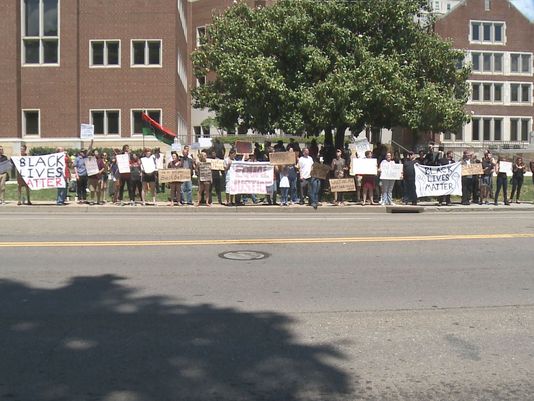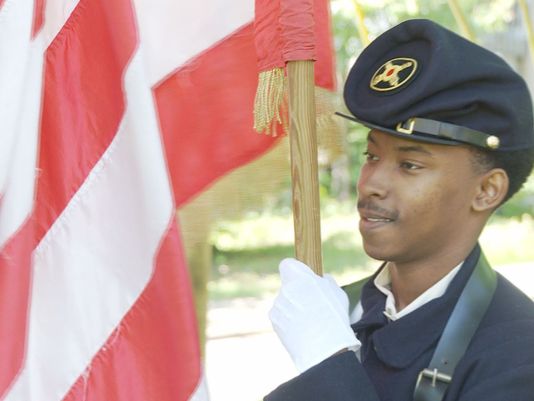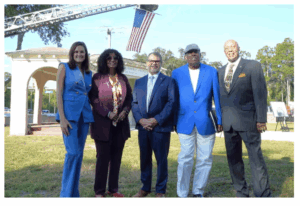TENNESSEE: Knoxville Protesters Stand in Unison With Baltimore
KNOXVILLE, Tenn. — Some University of Tennessee students and Knoxville community members are standing in solidarity with protesters in Baltimore.
They showed that support Saturday afternoon at a rally on UT campus, which drew more than 60 people. It was one of many such gatherings held across the country on Saturday.
This is in response to last month’s death of 25-year-old African American Baltimore man Freddie Gray, who died while in police custody.
Baltimore’s top prosecutor said Friday that the police officers illegally arrested Freddie Gray. She is pursuing criminal charges against all six of the officers involved.
Baltimore’s police union is standing behind the officers.
People at the Knoxville protest said they believe this is just the latest example of how the nation’s criminal justice system is broken.
With his camera at the ready, Jabari Guthrie captured the moments of Saturday’s #Knoxville2Baltimore rally, as part of his commitment to cover what’s happening in his community.
“I’ve made a vow to myself and East Knoxville to capture any type of police interaction I can possibly find,” Guthrie said, “because I understand that people react differently when they know they’re being watched by the camera.”
Guthrie posts his East Knoxville pictures to a Facebook page HERE.
He said he feels there’s distrust between police and the black community, especially when it comes to young African American men.
“They shouldn’t be thinking about how not to get shot by the police at the age of 16,” Guthrie said. “That’s a problem, and as long as we have the police and they’re more of, ‘It’s about dominance, it’s not about respect,’ then we’ll never see a change.”
People at the rally said America’s criminal justice system and society are stacked against people of color and that the system needs an overhaul.
“We’re not here to say, ‘See, look at us. We’re victims. We need you to support us,'” rally co-organizer and UT student Drost Kokoye said. “We’re here to say, ‘We’re fed up. We’re done with it. We don’t need your support. We’re going to do this on our own, and if you want to pick a side, we hope you pick ours, and if you don’t pick a side, know that you’ll be left behind.'”
She said small, subtle forms of racism – called microaggressions – can be just as dangerous as blatant discrimination.
“It’s hard for especially white people in dominant spaces to recognize microaggressions as harmful, as hurtful, because often times it is we become the butt of a lot of jokes,” she said. “If you are truly for the Constitution, then you will be for the freedom – the true freedom – and the true equality and liberation of all people here.”
Protestors say a needed cultural shift begins with understanding and respect.
“Get to know the people around you, no matter what skin color, no matter what religion they come from,” Guthrie said. “I have no problem against anybody, but I would like everyone to have compassion for each other. Love each other. Respect each other.”
At the same time and in the same area as Knoxville’s Baltimore rally, a small group of people came out to defend the Confederate flag. This protest came in response to an anti-Confederate flag event held Monday on UT campus.
These two protests happened to land on the same day.
Baltimore protestors called the flag a blatant sign of racism, but those defending it – including rally organizer Tom Pierce – said it’s a sign of Southern heritage, culture and pride.
“People’s going to say that, and it’s like, ‘Well, you know, that’s your opinion, that it’s a symbol of hate and racism,'” Pierce said. “You know, other people’s opinion is that the American flag is or the Christian cross is, you know. Do we quit being Americans and Christians because it offends people, you know? I mean, where do you draw the line when it comes to trying to appease everybody’s individual emotions and opinions?”
The two groups remained peaceful, though police were present in case anything got out of hand.
(WBIR – UT Campus)
###
TENNESSEE: African-American Troops Recognized for Civil War Efforts
Historic sites scattered through East Tennessee give visitors a gateway into the past.
“History, that is not studied, is lost forever,” said Stephen Scruggs, a member of the Knoxville Re-Animation Coalition.
Dressed in a traditional soldier uniform, he and others took part in a once-in-a-lifetime ceremony on Saturday. It was a celebration to mark 150 years since the end of the civil war, but this year’s anniversary brings honor to those whose efforts were once overlooked.
“They had a large part of the Civil War in Knoxville as well as they did in the entire country, the black troops,” said Scruggs.
A symbolic presentation welcomed records noting the names of African American soldiers.
Three thousand pages that were transcribed at the National Archives in Washington, D.C. The first United States Color Heavy Artillery was formed in 1864, just one year before the end of the Civil War.
During the 100th anniversary and 50th, black troops were not invited. The 150th anniversary brought change, and a chance to learn.
“For me personally it took me 50 years to learn this history,” said Scruggs, “I grew up in this community and I didn’t know that blacks fought in the Civil War or that blacks were buried in the cemetery.
His passion for the past is displayed even in the younger generation, like Travon Covington. He’s the youngest member of the color guard and a senior at L&M Stem Academy.
“It’s always honorable to hold our nations flag,” said Covington, “Being able to recreate what my ancestors did and participate and serve in their country it was an extreme honor, being able to honor those who had fought and died in this country.”
The colors he presented were not known as a flag during the Civil War. The stars are gold and not white like the American flag we know today.
Covington and Scruggs both encourage others to learn of their ancestry.
“Don’t turn your back on history, don’t ignore it,” said Scruggs, “Thirst for it, be hungry for it, embrace it and learn from it so it doesn’t get repeated and also so you’ll understand where you came from.”
For more information on the Blue & Gray Reunion and Freedom Jubilee
(WBIR)
###
VIRGINIA: Fredericksburg Popular Road Trip Destination
FREDERICKSURG, Va. —
Fredericksburg is historically tied to the Civil War and earlier, but that storied past has been linked to its more active present.
Karen Hedelt, director of economic development and tourism for the Virginia city, says visits to the area are increasing, because “you can be in a historic building downtown and hear some jazz next door.”
When a city can blend the past with the present, it becomes more active than towns that are little more than “historic amusement parks,” she says.
The city has seen increases of 1 to 2 percent in visits each year since the recession of 2008, she says. Hedelt says the city has become a way for visitors to the nation’s capital to escape the hustle of Washington, D.C.
As the childhood home of George Washington and the site of one Civil War battle with three others nearby, it’s still surrounded by the important aspects of the nation’s history.
BOTH SIDES NOW
Two vastly different sides of the Civil War can be examined at the Fredericksburg and Spotsylvania National Military Park.
The battle of Fredericksburg was fought in December 1862, when Gen. Ambrose Burnside tried to cross the Rappahannock River and move toward the Confederate capital in Richmond. Gen. Robert E. Lee, however, repulsed him in fighting on the hills and in the streets of the city.
The battles in the nearby Wilderness area and at Spotsylvania Court House in May 1864 were of a vastly different nature. They were part of Gen. Ulysses S. Grant’s efforts to wear down Lee through attrition. Wilderness was an inconclusive effort, and it led to Grant’s decision to move to another attack in a better location.
Both campaigns are examined in a film at the visitor’s center, where self-guided tours begin. Groups also are able to arrange guided tours for $200 to $300. The battlefield has plenty of trails through crucial areas and includes farm homes that were used as hospitals and now are museums.
Details: 540-373-0834 or nps.gov/frsp
THE PRICE OF PERFECTION
The Battle of Chancellorsville in May 1863 often is called Lee’s “perfect battle” because of his success at defeating a force about twice as large as his.
That victory, however, probably was the result of Gen. Joseph Hooker’s lack of nerve. It also resulted in the loss of one of the Confederacy’s best leaders, Gen. Thomas “Stonewall” Jackson. His death was to be severely felt at Gettysburg not long after.
Like the Fredericksburg site, the Chancellorsville Battle Visitor Center has a film on the encounter. It also offers a 35-minute Jackson Wounding Walking Tour that explores the battle and the death of Stonewall.
All of the areas can be seen in one day, but they offer enough history to fill two or more.
Details: 540-373-0834 or nps.gov/frsp
A FERRY-LAND BEGINNING
The farm where George Washington’s family moved when he was 6 was the site of a ferry to cross the Rappahannock River to Fredericksburg. Because of that, it became known as the Ferry Farm.
Today, a visitors center at the site has a collection of colonial and Civil War artifacts. A crew of archaeologists are in the process of examining the historically rich area. In 2008, they discovered the site of Washington’s boyhood home that burned in a fire in 1740.
Nearby is Kenmore, the plantation home built by Washington’s sister, Betty, and her husband, Fielding Lewis, in the 1770s.
Details: 540-370-0732 or gwffoundation.org
CLANG, CLANG, CLANG
Trolley Tours of Fredericksburg offers trips on trolley-like buses to historic sites and information on modern aspects, such as a good place to have dinner or shop.
A visitor can learn about museums and other places to visit when the 75-minute tour is over.
Rates are $17, $8 for those 5 to 12.
Details: 800-979-3370 or fredericksburgtrolley.com
SETTLING IN FOR A STAY
While it’s not difficult to find a place to stay in the Fredericksburg area, the Inn at Stevenson Ridge provides an unusual choice.
The inn has nine cottages and cabins dating back to the 18th and 19th century. They range in styles from rustic backwoods to modern efficiency and all include refrigerators, coffee makers and microwave ovens or toasters. One even is a plantation home moved from North Carolina.
Sizes vary, and each is rented individually to a couple, family or a group. Each site is pet-friendly for an added fee starting at $25.
Cabin rentals range from $150 to $425.
The inn is named for Union Brigadier Gen. Thomas Stevenson, who was killed nearby at the Spotsylvania Courthouse engagement. The battlefield is adjacent to the inn’s 87 acres.
Details: 540-582-6263 or stevensonridge.net
AN EVENT OF YOUR CHOOSING
For a relatively small town, Fredericksburg is an active place.
Its tourism guide has a section dedicated to events, and it breaks them down monthly. The month of May lists 48 events.
For music lovers, there’s singer Shirleta Settles’ May 9 tribute to Aretha Franklin and Etta James at the Cabaret at the Square (540-310-0063). Or, if you are a dog lover, the group Tripawds will have its fundraiser and “Pawty” (greyhoundsrock.org) on May 23 and 24 at the Hartwood Winery to fight canine cancer.
The May 15 James Monroe Walking Tour (540-654-1043) will examine the town as the fifth president knew it.
Details: visitfred.com
BIDDING CHEERS
Stafford and Spotsylvania offer another way to uncork a trip — the Grapes and Grains Trail.
The route includes four wineries, a brewery and a distillery that can be visited as a tour or one at a time. Tour tickets are $12 and do not expire.
Visits include tastings, a collectable, stemless tasting glass and discounts at all the trail shops.
All the stops are off Interstate 95, which gives a driver a perfect excuse to escape that busy highway.
Details: 540-658-8681 or tourstaffordva.com.
–triblive.com
###
NORTH CAROLINA: Civil War Commemorated
DOBSON — Although the Civil War ended 150 years ago, the significance of that bloody four-year conflict and the sacrifices it demanded of soldiers and families still resonate in Surry County, as evidenced by a ceremony Saturday in Dobson.
Celebrating any aspect of Confederate heritage is something many communities shy away from in this day and age — but that’s not the case in Surry, a county official told a crowd that filled an area in front of the old courthouse.

Tom Joyce | The News
Yadkin Gray County Eagles re-enactment troops fire a volley Saturday in remembrance of the 150th anniversary of the end of the Civil War and those who took part.
“It is a solemn occasion, and we felt it only fitting and proper in Surry County to pay homage to our ancestors who served in the Civil War,” Commissioner Eddie Harris told the gathering that included re-enactment troops dressed in gray.
Harris played a key role in organizing Saturday morning’s event along with members of educational groups such as the Surry County Historical Society and Gen. JEB Stuart Camp 1598 of the Sons of Confederate Veterans. He mentioned how some localities have shied away from commemorating the anniversary of the war’s end in 1865.
“But we wanted to make sure Surry County did it,” Harris said on behalf of the entire Surry County Board of Commissioners.
“We knew it was coming,” he added of the 15oth anniversary of the Confederate surrender. “We knew it ought to be observed.”
Buck Golding, another commissioner and board chairman, read a county government proclamation Saturday which cited the fact more than 1,000 men from Surry fought in the Civil War.
Greg Cheek, leader of the Yadkin County Gray Eagles re-enactment group that played a prominent role in Saturday’s program — including a 21-gun musket salute that reverberated throughout Courthouse Square — said more than 142,000 North Carolinians served. And out of that, about 42,000, roughly one of every three soldiers who fought, didn’t survive the war, a percentage Cheek said likely holds true for troops from Surry.
“Most of these men had never traveled beyond their communities,” said another speaker, Marion Venable of the Surry County Historical Society. “But suddenly, they found themselves hundreds of miles from home.”
Harris said that from his readings, the reason men fought for the Confederacy was the basic reason that their homeland was being threatened.
Troops coped not only with the fighting, but a lack of basic necessities such as food, clothing and shelter, Venable said.
Harris pointed out that those back home “suffered immensely as a result of the Civil War,” which deprived families of fathers and husbands and caused some to lose their property and face other economic hardships.
“Of which they are probably still a part of today,” Harris said of the lasting impacts of the war and how this is reflected in the character of modern Surry Countians.
“The unexpected length of the Civil War caused hardships on the home front,” Dr. Annette Ayers of the historical society said.
War hits home
The bulk of the fighting took place far away from Surry County at places such as Gettysburg and Antietam. However, this area did have encounters with Northern troops toward the end of the war when forces of Gen. George Stoneman swept through in April 1865.
Venable read one historical account from a female resident of Mount Airy who witnessed the Union soldiers mass there and wrote to her sister afterward: “The Yankees have been here. They say there was 7,000, but I don’t know how many there was…it was the most men I ever saw in all my life…they commenced coming about dark Sunday night and kept coming all night.”
The invaders initially struck communities along the Yadkin River such as Rockford, Siloam and Shoals, plundering stores and farms for livestock, food and various other supplies.
At one point, the Northern troops arrived in the county seat of Dobson, Venable related. “The men demanded money and papers from the county clerk — when he refused, we are told that some soldiers marched around the courthouse wearing the clerk’s wife’s clothes they had ‘borrowed.’”
Saturday’s program also included remembering those who have played a key role in documenting the war history through various books that enable modern generations to understand what occurred during that turbulent period.
First and foremost among them is the late Hester Jackson, a local historian who wrote a highly acclaimed book about Surry County soldiers who fought in the Civil War which continues to be widely consulted due to its unique perspective.
“I think I have to start my comments by recognizing Hester Jackson,” Venable said of Jackson’s contribution to preserving the lives and legacies of those who were involved. “Without her, we would know very little.”
Also during the program, the roster of Surry County soldiers present for the surrender at Appomattox was read to the crowd.
They included:
Henry Gray Anthony, Benjamin J. Baker, Daniel Barker, W.C. Banner, G.G. Boles, James Brannock, Daniel Brindle, James Brown, Jackson Burchett, John Cave, Reuben Cave, Arnold Coe, Anderson Creed, Jefferson W. Creed, Jonathan Daniel Creed, Jessie W. Cummings, Raleigh Davis, William A. Deatherage, C. Draughn, John Henry Edmonds, Mark H. Freeman, Nicholas Freeman, Albert L. Gates, Andrew Guyer, Jesse A. Holder, Hosea Lewis Horne, Edward R. Hull, Godfrey L. Isaacs, William A. Jenkins, G.M. Jervis, Ambrose M. Johnson;
Also, McGowan Johnson, Andrew Jackson Key, Pascal Lane, Henry Thomas Loggins, Edward F. Lovill, James Lemuel, McGee, Abraham William Minish, William Mitchell, Elijah Moore, F.W. Norman, Green B. Norman, Lacy J. Norman, Henry Payne, Enoch Ring, R.T. Saften, Alfred Sapp, Henry M. Scott, Abner Lee Snow, Miller W. Snow, G. Washington Swift, John H. Wall, William H. White, John F. Williams and Little C. York.
After the 21-gun salute, Saturday’s program ended with a ceremonial stacking of arms by the re-enactment unit.
–Mount Airy News
###





